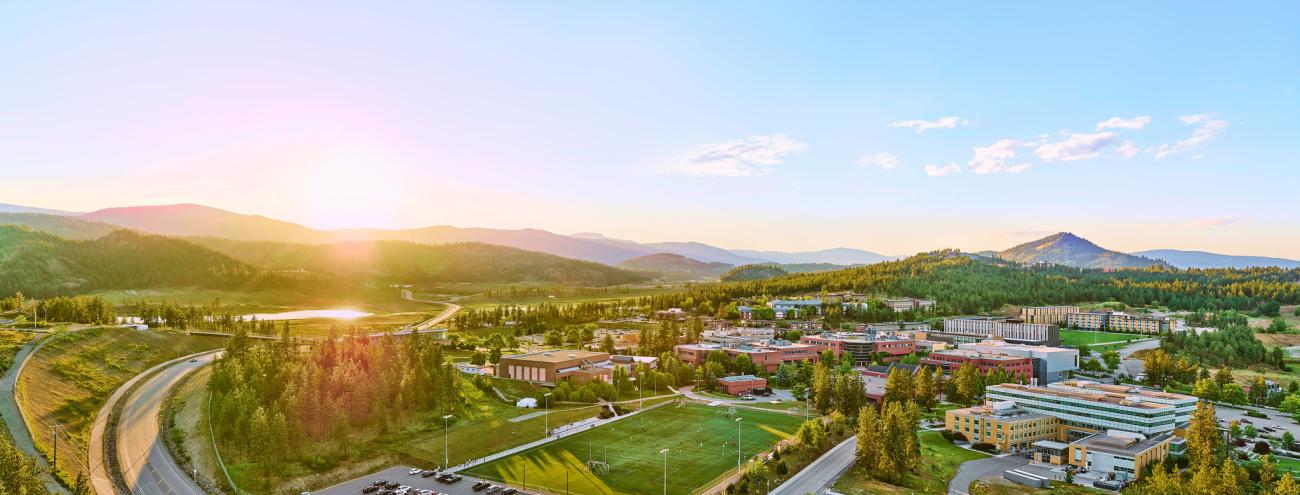
The smart fire detection system project aims to develop advanced, integrated fire-detection systems using multi-sensor networks for early wildfire detection and hotspots risk assessment at UBCO. This project is a collaboration between the School of Engineering and Facilities Management at UBCO.
We had the opportunity to speak with the following team members, who shared their insights with us :
- Qian Chen, Assistant Professor, School of Engineering
- Roger Bizzotto, Associate Director, Facilities Management
- Shahria Alam, Professor, School of Engineering
- Jinshuo Yu, Master Student, School of Engineering
Q: How did your previous research or work experience lead to this project?
Qian: The research trainees on the project team previously developed a fire detection system based on visible image analysis. For example, Eric Yang and Jack Li have experience with real-time data acquisition and analysis in Internet of Things (IoT) systems, and they have already conducted research on the fire spread process, changes in the thermal profile of a fire scene, early-stage fire monitoring methods, and fire monitoring methods using both infrared and RGB (red, green, and blue) visible images. The other trainees Jingshuo Yu and Ian Tu have studied how to synchronize the collection of thermal and RGB images using a Forward-Looking Infrared (FLIR) camera. My research on digital twins (virtual model of infrastructure) and Dr. Alam’s research on health monitoring of infrastructure using various sensors (e.g., Wilden Living Lab project) were key to bringing this new project forward.
Q: Why is this project essential for UBC Okanagan and beyond?
Qian: This project seeks to develop a customized fire warning and detection solution for UBCO Campus by leveraging cutting-edge technology. While many current solutions offer fire monitoring capabilities, there is a recognized need for a reliable system that is specifically designed to address the unique conditions of our campus environment – specific hotspot and high risk areas. By incorporating the latest vision algorithms, we aim to enhance the timeliness of our warnings. That being said, we are also mindful of the importance of scalability and interoperability, and we hope to contribute to improved safety measures not only for our campus but also potentially for broader applications beyond UBC Okanagan.
Shahria: This project offers the potential to integrate more diverse fire warning and detection hardware, additional sensors, latest algorithms, and establish a highly sensitive and robust fire warning and detection system for future developments.
Q: What aspects of this project are most fascinating to you?
Qian: The outcomes of our project, the virtual watchtowers for wildfire risks and the digital dashboards to support facilities management in proactive decision making, can substantially improve school community well-being and safety and safeguard high-risk individuals on campus. The most exciting component is this opportunity to collaborate closely with UBCO Operations team and communities to understand how technological innovations can be adapted and implemented to meet the emergent needs of our campus.
Shahria: Last year’s wildfire required my family to evacuate with only ten minutes notice, a harrowing experience. Through our research, we aim to develop technology that significantly enhances the safety and security of lives and infrastructure.
Jingshuo: Personally, I am most excited about how we can develop an accurate detection model with limited multimodal fire data. We will try applying methods like transfer learning, which I find challenging and interesting.
Q: How does this project contribute to UBC Okanagan’s strategic objectives?
Roger: UBC has recently completed the first phase of an ‘All Hazards’ resiliency plan. Phase 1 identifies hazards related to climate change and its impact on campus infrastructure. One of the top 3 hazards identified through this process is wildfire. Phase 2 will be underway soon and it intends to develop implementation plans focusing on increasing resiliency of hazards including wildfire. This CLL project is already forming into an action item in line with phase 2 by developing early smoke and wildfire detection through AI and automation. Additionally, according to the university’s strategic plan, the UBC Okanagan campus will be expanded around Skeena Residence and Innovative Precinct, which are the intended installation sites of our cameras. Our accurate and automated fire detection system can enhance fire resilience in the two sites and serve as the backbone for the safety of the community.
Q: What is the envisioned impact of these fire detection systems?
Roger: The concept is that ‘virtual towers’ through algorithm learning can be deployed in strategic locations around campus to ‘keep an eye’ on the higher risk areas such as building roof tops, forested areas, and campus trail networks. Early detection can automatically initiate response by UBC operations teams and if required, assistance from emergency services, potentially keeping people and property safe.
Qian: For the technical innovation aspect, our fire detection system is expected to revolutionize the fire detection method by switching it from a manual way to an automated way. Through automatic workflows, UBC Okanagan campus will reduce costs on operations and maintenance, and carbon emission and property loss caused by fires will also be decreased.